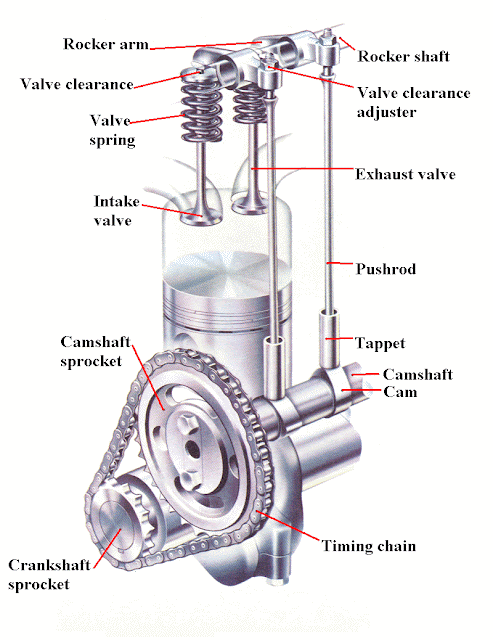We previously looked at Overhead Valve (OHV) engines. In this post we will take a look at Overhead Cam designs, as well as another really unique means of opening and closing engine valves...
The V-8 and Inline-6 cylinder configured OHV engines had a remarkably long run in the US. They were used in everything from tractors to muscle cars. The advantage the OHV designs had over the flathead engines was mainly ease of valve adjustment and repair. The materials of the era were not very robust, and so life was easier removing a valve cover for repairs or adjustment. Flathead engines require pulling the oil pan and going into the engine block to make valve adjustments.
Stricter emission regulations, improved power output, and higher tolerance engineering all paved the way for Overhead Cam engines.
Below, the older Overhead Valve (OHV) engine. The camshaft that actuates the pushrods is mounted in the engine block, and there are a lot of reciprocating valve gear parts. There is room for improvement!
An improvement on the OHV is the Single Overhead Cam (SOHC) design. The camshaft is relocated to the cylinder head, and operates the valves either directly or via rocker arms. Note that if the SOHC operates the valves directly, they must all be aligned with the cam, and so intake-exhaust cross flow across the piston is not possible, making engine breathing a problem. Below is a cutaway of a direct-acting SOHC configuration.
Overhead Cam engines frankly are a little non-descript. They don't quite look like any other design, but neither do they have remarkable features to point to, other than a fairly wide valve cover. Below are a couple of images of SOHC engines. One visual cue for overhead cam engines is a belt or chain drive from the crankshaft to the overhead cam.
SOHC Honda V-Tec. The OHC cam drive is a belt at the right of the engine, inside a guard.
Honda CB750 motorcycle engine. The OHC drive is a chain between #2 and #3 cylinder.
Below is a SOHC rocker-type design, allowing flow of the intake/exhaust across the cylinder head. This would be the design used in the above two engines, since both are clearly cross-flow designs.
The SOHC design has some shortcomings though, and that is because rocker arms are still required. The rocker arms add reciprocating mass in the valve train, which is wasteful and can lead to valve float at high engine speeds. Valve float occurs when the valve springs cannot close the valve quickly enough to keep the rocker arm in contact with the camshaft as the lobe rotates away. The danger with valve float is that the valve can be partially open (i.e. down inside the cylinder) when the piston rises to the top of its travel. The piston and valve then collide and damage the engine.
If we were to add a second overhead cam, we could operate all the intake valves directly with that cam, and all the exhaust valves directly with the second cam. This is called the Dual Overhead Cam (DOHC) design, which is widely used in modern engines.
Below, a diagram of a DOHC cylinder head. As you can see, the rocker arms (and their reciprocating mass) are eliminated, and the intake/exhaust gas can still flow directly across the cylinder. Truly a thing of engineering beauty!
The lower reciprocating mass of the valve train means that valve float will occur at much higher engine speeds, and thus higher RPM and power output are achievable with a DOHC engine.
With very little extra engineering and expense (compared to any other engine design) an additional intake and exhaust valve can be added to each cylinder. Four valves per cylinder greatly improves airflow through the engine, increasing power output significantly.
Identifying a Dual Overhead Cam engine is simple. There is a valley between two camshaft covers where the sparkplug wires terminate, and the intake will be on the opposite side of the engine from the exhaust. Below, the Lotus Twin Cam
Below the Dual Overhead Cam Kawasaki Z1 engine. Helpfully it says "DOHC" on the ignition cover :)
Below, the Jaguar E-Type engine. This engine was actually designed with aesthetics in mind :)
Lastly I wanted to mention a special type of valve train that does not rely on springs to close the intake and exhaust valves, and is therefore immune to the issue of valve float. This is the Desmodromic valve train, invented by Gustav Mees, and used today only by Ducati. With the desmodromic design, the valve is both opened and closed by a cam. Very clever!
Below, an animation of a desmodromic valve.












1 comment:
Thankss for sharing
Post a Comment